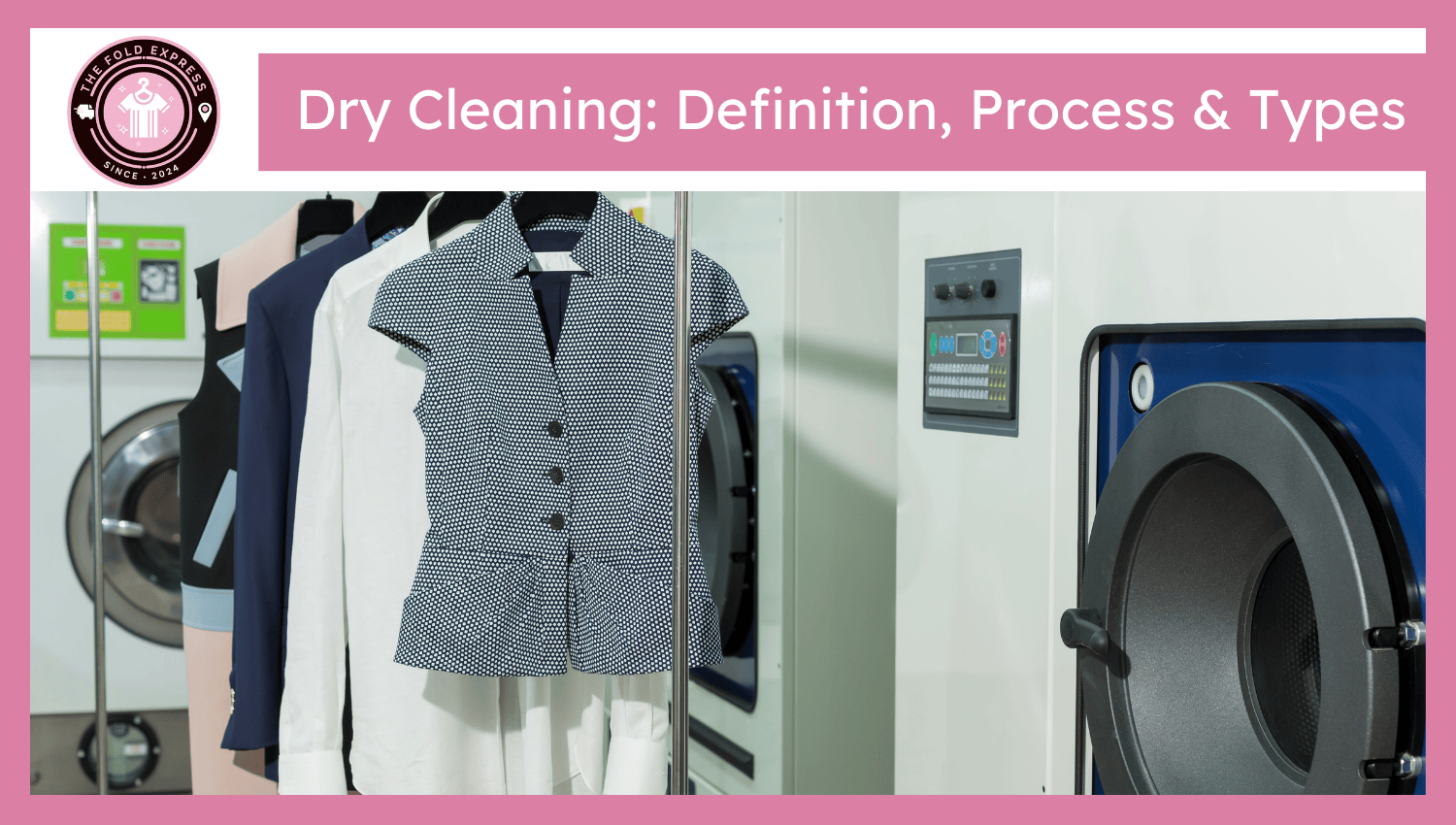Dry cleaning functions as a water-free procedure used to clean garments. The cleaning process relies on liquid solvents that extract stains from fabric materials without damaging the fabric’s quality. Dry cleaning is most effective for cleaning both delicate garments and complex or special items. The dry cleaning method has become safer with the use of solvents over the years. The modern dry cleaning process preserves both the freshness and crispness and the longevity of clothes. People use dry cleaning services to maintain their suits, silk dresses, and upholstery items. More and more businesses are offering eco-friendly cleaning products, which means we now have safer options for keeping things clean.

How Does Dry Cleaning Work?
Dry cleaning is a step-by-step process that helps clean and take care of your fabrics. Here are the 5 main steps that are involved in dry cleaning.
- Inspection & Tagging
- Pre-Treatment
- Cleaning with Solvent
- Post-Treatment & Pressing
- Packaging & Delivery
Checking and Labeling
A thorough inspection of every item of clothing is conducted to check for stains, wear, and material content. Special markings are used to help avoid mistakes. It helps to ensure clothes are properly cleaned and returned to the original owner. Garment inspection identifies the best way of cleaning, especially in soft or shaped garments. It also identifies repairs that can be done. Proper labelling is greatly important in professional dry cleaning to maintain accuracy and quality service.
Pre-Treatment
Spots and stains are pre-treated with professional solutions before they are cleaned. Pre-treatment prevents stains from becoming more fixed when clothes are washed. Different fabrics require different treatments to get rid of stains without destroying them. This process provides a more detailed cleaning, and clothes feel clean and well cared for. Professional dry cleaners utilize their expertise to retain the quality of fabric while removing stubborn stains.
Cleaning with Solvent
Instead of water, a special liquid called solvents is used to clean clothes. Solvents remove stains, dirt, and oils without affecting delicate fabrics. The dry cleaning machine is fitted with filters to clean and recycle the solvent appropriately. In contrast to water washing, the procedure never causes clothes to shrink or lose their color. It is the best way to handle delicate fabrics, closely fitting clothes, and embroidered clothes. The use of solvents is one of the primary reasons why dry cleaning extends clothes’ longevity.
Post-Treatment & Pressing
Once cleaned, any remaining stains are treated. Clothes are pressed to restore them to their original shape. Some machines are designed to eliminate creases and wrinkles, and the clothes look neat and professional. Pressing prevents well-fitting clothes, such as coats and suits, from becoming sloppy. The final process gives dry-cleaned clothes a look and freshness.
Packaging & Delivery
Packing and Delivery Clothing is packaged after washing and ironing. During packaging, garments are protected by plastic wraps in order to keep them away from water and dust. Special packaging is done by dry cleaners to package sensitive or designer fabrics. Correct packaging keeps clothes clean and crease-free until they are worn. Clean clothes are delivered or kept for pickup, which is convenient for customers.

Types of Solvents Used in Dry Cleaning
Below are the 4 main types of solvents that are used in dry cleaning
- Perc (Perchloroethylene)
- Hydrocarbon Solvents
- Liquid Silicone (GreenEarth Cleaning)
- Wet Cleaning
Perc (Perchloroethylene)
Perc is a common dry cleaning solvent that works well in stain removal. It works nicely in oil stain removal and dirt. It is regulated, however, because it is harmful to the environment and human health. Most dry cleaners are converting to safer alternatives.
Hydrocarbon Solvents
Hydrocarbon solvents are a lighter alternative to perc. It cleans effectively without causing any damage to sensitive fabrics. This method is less harmful to sensitive skin and reduces environmental threats. It is most commonly used for silk, wool, and formal clothing.
Liquid Silicone (GreenEarth Cleaning)
GreenEarth cleaning uses liquid silicone, a non-toxic and biodegradable solvent. It is kind to sensitive fabrics and the environment. This method is becoming super popular with eco-friendly dry cleaners and people looking for green options.
Wet Cleaning
Wet cleaning utilises water and mild soaps. This method is similar to dry cleaning, but it uses less energy and is more environmentally friendly. This is particularly suited to some of the most sensitive fabrics and reduces chemical use to a bare minimum.
What Fabrics Require Dry Cleaning?
Here are 3 groups of fabrics that should definitely be dry-cleaned:
- Delicate & Luxury Fabrics
- Structured & Tailored Clothing
- Home Textiles & Specialty Items
Delicate & Luxury Fabrics
Luxury materials such as silk, wool, velvet, cashmere, and linen require special attention to maintain their softness and lustre. These materials are highly sensitive to water, and it can cause them to shrink, become rigid, or compromise the fibres. For instance, wool loses its natural oils and becomes stiff and dry. Silk has water spots that are hard to remove. Dry cleaning prevents these materials from becoming rough, dull, and weak. Luxury materials are expensive and used to make complex clothes, so they are cleaned carefully to keep them in good shape for long-term use.
Well-Fitting and Custom-Fitted Apparel
Structured clothing, such as suits, blazers, coats, and professional dresses, must be dry-cleaned to remain sharp. Structured garments are normally made of fine fabrics and must be pressed and moulded carefully. Home washing destroys the shape of suits and blazers, and embellishments on dresses become loose or detached. Dry cleaning preserves the original shape and professional appearance of these garments. Dry cleaning also preserves the condition of buttons, zippers, and decorated sections. If you prefer your structured garments to appear clean and orderly, professional dry cleaning is the most suitable option for them.
Home Fabrics and Special Products
Home furnishings such as curtains and upholstery collect dust, dirt, and smell over time. Washing them in a machine is not often an option since they are large and heavy. Dry cleaning removes deep dirt without damaging the fabric. Wedding dresses and occasion wear, which are usually made of lace, beads, or heavy embroidery, require special treatment. Dry cleaning keeps these clothes in very good condition without damaging delicate areas. For freshness and longevity over the long term, dry cleaning is the best option for occasion wear and home furnishings.
How Often Should You Dry Clean Clothes?
The frequency of dry cleaning depends on fabric type as well as wear frequency and stain presence. The fabric requires careful attention when you wash it because overwashing might lead to damage yet insufficient cleaning allows stains to solidify. Dry cleaning services are necessary at least every 3 months up to 6 months for suits, blazers, and coats along with a maximum of 5 years. You need to clean silk along with wool and cashmere after 2–3 times of wear. Formal dresses together with wedding gowns require a professional cleaning service directly after their first use. The recommended schedule for cleaning curtains and upholstery is two times per year or 6–12 months. The process of dry cleaning maintains both cleanliness and proper condition which extends the usability of your clothes.
What are the Common Myths & Facts About Dry Cleaning?
Here are the 3 common myths & facts about dry cleaning:
- Myth: Dry Cleaning Damages Clothes
- Myth: All Clothes Can Be Dry Cleaned
- Myth: Dry Cleaning is Only for Fancy Clothes
Myth: Dry cleaning destroys clothing.
The dry cleaning process proves more gentle for clothes than regular washing procedures. Water-based cleaning solutions together with soap create wear and tear on fabrics through their breakdown of material as well as their ability to shrink fabrics and damage color. The dry cleaning process utilizes specific solutions to cleanse the clothes without applying mechanical friction. The dry-cleaning process maintains the fabric’s strength while preserving its softness and increasing its durability. The sensitive materials made from wool and silk must experience dry cleaning to protect them from premature wear.
Myth: All Clothes Can Be Dry Cleaned
Dry cleaning solutions work only on specific items. Most fabrics including cotton along with polyester are safe for home cleaning methods. Professional cleaners with expertise specialize in cleaning expensive materials together with fragile objects. Clothing tags serve as an essential warning sign about the required cleaning procedure so customers must read them first. The label “Dry Clean Only” indicates that water exposure may cause materials to shrink and fade along with a loss of shape.
Myth: Dry Cleaning is Only for Fancy Clothes
Dry cleaning is a cleaning method that goes beyond formal clothing care. Dry cleaning services professionally handle work-related clothes together with winter jackets as well as upholstery fabric and casual high-end fabrics. Dry cleaning specialists can eliminate deep stains from items while blocking smells and restoring their original fresh look. To preserve your everyday clothing items for many years dry cleaning services prove to be an appropriate solution.
Your clothes require proper care decisions which you can set after knowing dry cleaning truths and common misconceptions. Dry cleaning proves to be an effective method for maintaining the best quality of your clothes and preserving their appearance and extended lifetime.
Professional Dry Cleaning Services in Miami
Professional dry cleaning services in Miami provide specialized care for delicate fabrics and formalwear. They use solvent-based cleaning technology which removes stains while preserving fabric texture while maintaining the original color. Dry cleaning services are perfect for preserving both suits and dresses and special garments and they maintain clothes in high quality condition. The dry cleaning process for each item involves inspection followed by cleaning and pressing before neat package delivery. The convenient pickup and delivery system from Miami Dry Cleaners enables time savings for those who lead busy lives. Professional garment care services both enhance the appearance and preserve the longevity of expensive clothes.



